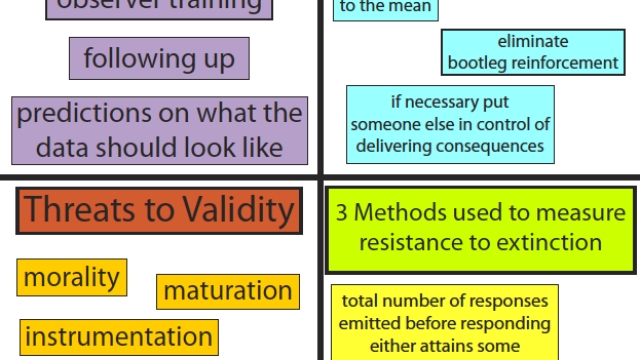Unleashing the Power of Applied Behavior Analysis: Creating Lasting Behavior Change
In today’s world, where personal growth and development are highly prized, finding effective methods to create lasting behavior change is of utmost importance. Applied Behavior Analysis (ABA) has emerged as one such powerful tool that has revolutionized the field of behavior modification. ABA therapy, based on the principles of Applied Behavior Analysis, offers individuals the opportunity to understand and modify their behaviors in order to achieve meaningful and sustainable change.
At its core, ABA therapy is a branch of psychology that focuses on utilizing the science of applied behavior analysis to address a wide range of behavioral challenges. By analyzing behavior patterns and their underlying causes, ABA therapists are able to design targeted interventions and strategies that help individuals develop positive behaviors and reduce or eliminate negative ones.
The real strength of ABA lies in its application across various domains and populations. From helping children with autism spectrum disorder to assisting individuals struggling with addictive behaviors, ABA therapy has proven to be versatile and adaptable. Its evidence-based approach ensures that interventions are tailored to the unique needs of each individual, increasing the chances of successful behavior change.
As we delve deeper into the world of applied behavior analysis, this article aims to explore the principles and techniques underpinning ABA therapy. By understanding the core components of ABA, we can unlock its transformative power and harness it to create lasting behavior change. Whether you are a parent seeking effective strategies for your child or an individual looking to overcome personal challenges, the principles of ABA provide a roadmap for personal growth and progression.
Join us as we unravel the secrets behind applied behavior analysis and discover how it can unleash the power within each individual to achieve lasting behavior change.
ABA therapy for social skills development
Understanding ABA Therapy
ABA therapy, also known as Applied Behavior Analysis, is a scientific approach that focuses on understanding and modifying behavior. It is widely regarded as an effective intervention for individuals with autism spectrum disorder (ASD), as well as other developmental disabilities. ABA therapy aims to bring about positive and lasting behavior changes by utilizing proven strategies and techniques.
The core principle of ABA therapy is based on the belief that behavior is learned and can therefore be modified through systematic and individualized interventions. By analyzing and comprehensively assessing the factors that influence behavior, such as environmental variables and reinforcement patterns, ABA therapists are able to develop customized intervention plans that target specific goals.
One of the key aspects of ABA therapy is its emphasis on data collection and analysis. Therapists meticulously track and record behavior patterns, enabling them to objectively evaluate progress and adjust intervention strategies accordingly. This data-driven approach provides valuable insights into an individual’s progress, helping therapists to identify areas of improvement and implement necessary adjustments to the treatment plan.
ABA therapy is a comprehensive and versatile approach that can address various areas of development, including social skills, communication abilities, and adaptive behavior. Therapists may employ a range of techniques within the ABA framework, such as discrete trial training and naturalistic teaching methods, to target specific skill deficits and facilitate generalization across different settings.
In summary, ABA therapy is a powerful tool that can effectively promote positive behavior change in individuals with developmental disabilities. By utilizing evidence-based strategies and tailoring interventions to meet individual needs, ABA therapists aim to enhance quality of life and foster meaningful progress for those they serve.
The Principles of Applied Behavior Analysis
Applied Behavior Analysis (ABA) is a therapeutic approach that focuses on understanding and modifying human behavior in order to achieve meaningful and positive changes. It is widely recognized as an effective intervention for individuals with various developmental and behavioral challenges.
The core principles of ABA therapy are based on a scientific understanding of how behavior functions and how it can be shaped through systematic analysis and reinforcement. By breaking down behavior into its individual components, ABA therapists can identify the underlying causes and develop targeted interventions to promote growth and learning.
One fundamental principle of ABA is the concept of positive reinforcement. This involves providing meaningful rewards or incentives to reinforce desired behaviors, thereby increasing the likelihood of their recurrence. Positive reinforcement can be tailored to individual preferences, making it a powerful tool for motivating change.
Another key principle is the use of prompting and fading techniques. Prompting involves providing cues or guidance to help individuals learn and perform specific tasks or behaviors. Over time, prompts can be gradually faded out, allowing individuals to independently engage in the targeted behaviors.
ABA also emphasizes the importance of data collection and analysis. By systematically collecting and analyzing data, therapists can objectively evaluate the effectiveness of interventions and make informed decisions about treatment plans. This data-driven approach ensures that therapy is individualized and tailored to the unique needs of each person.
In conclusion, ABA therapy is guided by principles that are grounded in scientific research and understanding of behavior. By leveraging the power of positive reinforcement, implementing prompting and fading techniques, and using data to inform decision-making, ABA therapists can create lasting behavior change and improve the lives of individuals with various challenges.

Effective Techniques for Lasting Behavior Change
One powerful technique used in ABA therapy for creating lasting behavior change is positive reinforcement. By providing rewards or incentives for desired behaviors, individuals are motivated to continue engaging in those behaviors. This can be done through verbal praise, tokens, or other forms of rewards that are meaningful and significant to the individual. Reinforcement helps to strengthen the connection between the desired behavior and the positive outcome, making it more likely for the behavior to occur again in the future.
Another effective technique in Applied Behavior Analysis is the use of behavior contracts or agreements. These written agreements clearly outline the expectations, goals, and consequences for behavior. By involving the individual in the process and having a clear understanding of what is expected, behavior contracts can serve as valuable tools for creating lasting behavior change. They provide a tangible reminder of the desired behaviors and the reinforcement or consequences associated with them.
A third technique utilized in ABA therapy is the use of visual supports, such as schedules or visual prompts. These visual aids help individuals with understanding and following routines, as well as providing reminders of appropriate behaviors. Visual supports can be particularly effective for individuals with autism or other developmental disabilities, as they provide a concrete and visual representation of expectations, which promotes greater independence and success.
Overall, by combining positive reinforcement, behavior contracts, and visual supports, ABA therapy harnesses the power of applied behavior analysis to create lasting behavior change. These techniques help individuals understand expectations, stay motivated, and effectively engage in desired behaviors, leading to improved outcomes and quality of life.



